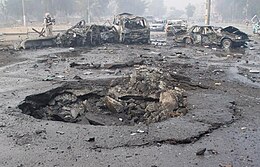
Back سيارة مفخخة Arabic Coche bomba AST Bombalı maşın Azerbaijani Кола бомба Bulgarian Cotxe bomba Catalan Bilbombe Danish Autobombe German Bombaŭto Esperanto Coche bomba Spanish Bonba-auto Basque

| Part of a series on |
| Terrorism |
|---|
A car bomb, bus bomb, van bomb, lorry bomb, or truck bomb, also known as a vehicle-borne improvised explosive device (VBIED),[1] is an improvised explosive device designed to be detonated in an automobile or other vehicles.
Car bombs can be roughly divided into two main categories: those used primarily to kill the occupants of the vehicle (often as an assassination) and those used as a means to kill, injure or damage people and buildings outside the vehicle. The latter type may be parked (the vehicle disguising the bomb and allowing the bomber to get away), or the vehicle might be used to deliver the bomb (often as part of a suicide bombing).
It is commonly used as a weapon of terrorism or guerrilla warfare to kill people near the blast site or to damage buildings or other property. Most people that would make the bombs, would install more than one because it takes a good deal of time and also it takes a lot of skill.[2]Car bombs act as their own delivery mechanisms and can carry a relatively large amount of explosives without attracting suspicion. In larger vehicles and trucks, weights of around 5,000 pounds (2,300 kg) or more have been used, for example, in the Oklahoma City bombing.[3] Car bombs are activated in a variety of ways, including opening the vehicle's doors, starting the engine, remote detonation, depressing the accelerator or brake pedals, or simply lighting a fuse or setting a timing device.[4] The gasoline in the vehicle's fuel tank may make the explosion of the bomb more powerful by dispersing and igniting the fuel. Car bombs can not only be dangerous physically, but it can impact people mentally. Car bombs are linked to post traumatic stress disorder in people who have experienced car bombs.[5]
- ^ Kaaman 2019, pp. 1−3.
- ^ Jha, Rajshekhar (17 February 2019). "Why car bombs are worrying our forces". The Economic Times. ProQuest 2181845864.
- ^ "The Oklahoma City Bombing 20 Years Later". Federal Bureau of Investigation. Retrieved 30 September 2023.
- ^ Wilkinson, Paul; Christop Harman (1993). Technology and terrorism. Routledge. ISBN 0-7146-4552-4.[page needed]
- ^ Dulin, Adam L.; Patiño, Jairo (December 2014). "The logic of cartel car bombings in México". Trends in Organized Crime. 17 (4): 271–289. doi:10.1007/s12117-014-9230-z.
© MMXXIII Rich X Search. We shall prevail. All rights reserved. Rich X Search